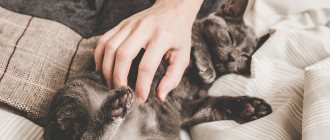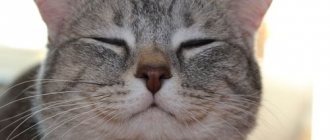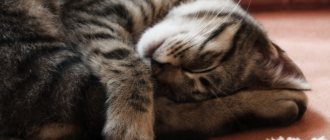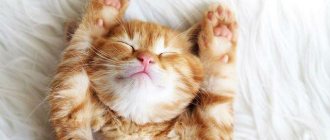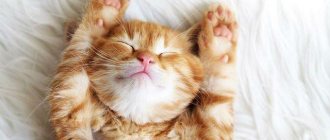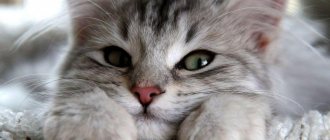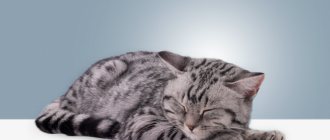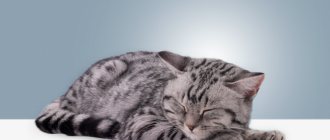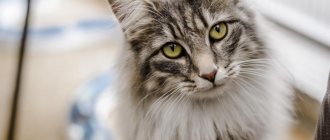Specifics of sounds made by cats
A cat purrs when it feels pleasure and more.
Many owners of furry pets have probably wondered why cats purr. In order to communicate with people or other animals, cats use various types of communication. Rumbling is one of them. A pet can show its mood through various gestures, the position and vibration of its tail, and also by making sounds.
Why might an animal bite while ironing?
It always looks very strange when you pet your pet, and he seems to purr, but suddenly bites you, trying to open the veins. In fact, this behavior does not mean at all that your pet is unhappy. He doesn't mind demonstrating his love, but at the same time he is categorically against you touching him now. There is also a possibility that you touched him or stroked him incorrectly.
Are all cat breeds equally talkative?
Zoologists claim that there are breeds that are hereditarily conditioned to be more “talkative,” and there are others that are the opposite. For example, Cornish Rex, Siamese, and Thai are considered very talkative. Devon Rex and Ragdoll are less talkative. These factors need to be considered before taking a pet into your home.
Regardless, you should enjoy the time you spend with your pet. It’s so nice to pet a purring kitten after an active day. After all, in this way they give us their love and affection.
The benefits of purring
There is a theory that purring can cause cats to produce a hormone that helps strengthen and grow bone tissue. Since most of the time the animal is passive, it needs restoration of the musculoskeletal system.
Cat purrs calm and relax people, helping relieve stress and lower blood pressure. The sound of purring is at a frequency of 20 to 44 Hz. It is capable of starting healing processes in humans, similar to ultrasound treatment.
One theory says that cats are able to treat gastritis, colitis and other gastrointestinal diseases in their owners with their purring.
Anatomical mechanism that produces purring sounds
In general, purring is a long, rhythmic vibrating sound that only cats can make.
For a long time, scientists did not know exactly how purring occurs, since there is no separate special organ responsible for these sounds.
The latest and most accurate version is that the sound is produced by the hyoid bones. Electrical impulses in the brain travel to the muscles near the vocal cords, and in turn cause the muscles also nearby to vibrate.
Scientists have found that the average frequency of purring in domestic cats is 20–30 hertz. In this case, the frequency of, for example, cheetahs is 18 hertz.
It is interesting that a person cannot learn to purr, no matter how much he wants to, since people do not have the appropriate structure and do not have hyoid bones. So all that a person can make are certain sounds.
Many representatives of wild cats can also only growl, but not meow. This is explained by the fact that their hyoid bones are overgrown with cartilage, so they can no longer act on the muscles next to the vocal cords.
Which organs are responsible for a cat's rumbling?
Sometimes you may come across the statement that if a cat purrs, it does so either through its nose or through its throat. This is not entirely true: the brain is the main organ that causes cats to purr. Of course, the sounds themselves are produced by the vocal cords, which vibrate due to the movement of the vocal muscles located in the larynx. However, without a corresponding signal from the brain, the muscles will not begin to move on their own. That's why cats never rumble or purr for no reason; there must be something that spurs their brain to reproduce the command to “sing,” for example, seeing a sparrow outside the window or inhaling the aroma of fried fish.
Big cats purr too
So, cats purr for many reasons. Can their large wild counterparts make similar sounds? Or is rumbling a privilege only for domestic cats? The answer is: wild cats can also purr: lions and tigers, leopards and pumas, lynxes, jaguars and other representatives of the cat family. However, it is important to note that the larger the cat, the louder and more menacing its purring sounds, since the cartilage of their larynx is too hard to reproduce such measured sounds that an ordinary cat is capable of “singing.” For example, in the same lions, the peaceful rumbling sounds more like a roar.
The main reasons for a cat's purring
A cat purrs when it feels safe, but may also purr to relieve stress or pain.
A cat's purr is never without a reason. Purring expresses their emotional and physical state.
Read also: Is it possible to “swell” from hunger?
It is generally accepted that cats purr only when they are happy. Surely in most cases it is for this reason.
However, a cat's purring can also be detected when the cat is excited, scared, injured, before giving birth and at other exciting times. Why does she purr when he is stressed? In this way, the animal calms and heals itself.
To better understand the reason for purring, let’s look at the accompanying actions of the animal.
- It stomps its paws on or near a person and purrs. The animal marks its owner in this way, demonstrating its own importance.
- Rumbling when stroking indicates that the cat is receiving true pleasure.
- A loud, restless purr, similar to a tractor, accompanied by accompanying soft and cute movements, may indicate an injury to the animal. It is necessary to pay attention to whether she is experiencing a painful condition, whether she is trying to crawl out of the wound, whether she is experiencing discomfort and other disturbances in her general condition.
- The purr of a mother cat while feeding her cubs calms the babies.
- A cat may also purr after a tasty and satisfying meal and during a nap.
- A cat's purring can also be its anticipation of pleasant moments: treats, emotions, games.
- A caring pet may begin to purr, sensing the painful state of its owner, in an attempt to calm him down.
- A cat purring during a meeting with a veterinarian may indicate that the animal is stressed and trying to calm down.
Cats purr when communicating with their own kind.
In addition, cats also purr when communicating with their own kind. If a cat purrs when meeting another animal again, this indicates that she is in a friendly mood. The purring of a cat during aggressive play or a fight with another cat is evidence that she is giving up and raising the “white flag”.
Rumbling can also express boredom, or a cat may begin to purr before a serious and responsible action, such as jumping from a high cabinet.
Scientists have not yet figured out the exact reasons for the start of the rumbling mechanism in mustaches.
Interesting: Cats can’t purr in their sleep, but they can easily purr during a nap.
Why does he purr when you pet a cat?
Don't be surprised if you pet your cat for a long time and he will start purring. This is connected precisely with receiving positive emotions. The animal likes such stroking, it calms it down. Accordingly, the cat makes a characteristic sound. Sometimes pets can come to their owners, lie down next to them and purr for no apparent reason, even if you don’t pet them. This is connected precisely with the desire to improve health.
Often cats lie down near the area that is sore. Perhaps these are chronic diseases. It is at such places that cats lie down, lean against them and purr. In this way they try to cure their owner. A cat may purr for the simple reason that it is hungry or wants to go for a walk. Accordingly, in this case, the nature of the purring will be different.
Petting the cat
How the purring mechanism is started
Scientists do not fully understand how cats purr. The vocal cords are responsible for the sound, but vibration is explained by more interesting reasons.
Physiological features
The most popular theory to explain how cats purr is the one that focuses on the hyoid bones. In domestic animals they take the shape of a triangle, and in wild animals they take the shape of a rectangle. Because of this, wild feline predators are rarely found purring.
Everything is easier with sound. It passes through the animal's nose and mouth. The heart and lungs at this moment cannot be listened to.
What is known for certain about vibrations is that they appear based on a signal from the brain. When receiving positive and negative emotions, it sends neurons to the responsible organ. This helps to guess what cats purr about.
Unproven facts
When discussing how cats purr from a physiological point of view, we take as a basis the muscles located behind the vocal cords. Their contraction leads to vibration of the hyoid bones, spreading throughout the body. This theory is the most popular, but there are several others. They explain that purring occurs through:
- Lungs
. A purring pet is the result of the work of the diaphragmatic and intercostal muscles. It is assumed that during the breathing process they create sound vibrations of different amplitudes. This is the least popular theory, since the intensity of the purring does not change with inhalation and exhalation.
- False ligaments
. They are located directly above the vocal cords and look like a bunch of elastic membranes. According to this theory, sound vibrations appear due to changes in pressure in the circulating bloodstream. This causes the chest to vibrate and transmit sound to the sinuses.
The hyoid bone theory is more convincing. This is confirmed by the absence of purring in cats with laryngeal paralysis.
What is purring and who, besides a cat, makes it?
It is believed that a cat's purring calms both the pet and others. Although objectively this acoustic vibration can also be an alarming signal.
Not only domestic cats purr, but also some inhabitants of the wild world:
- Gorillas, elephants and squirrels can rumble. The desire to express pleasure sometimes appears during food.
- Hyenas, foxes and bears with badgers also periodically grumble and make a sound similar to the purring of a cat.
- A team of predators (from lynx to tiger) is “carried away” by purring singing.
A person hears all this motley “company” only in the zoo from a safe distance, but the sounds of cats at any volume level can be fully enjoyed at home.
If we formulate it without emotional connotation, then purring cats produce a vibrating sound of varying duration in a predominantly low tonal register.
Although there is some gradation in the cat’s vocal roulades, it relates more to the place and circumstances - the cat’s purring changes even depending on the mood of its owner, on whose lap it is located.
This is interesting! Even musicians who can imitate the voice of any animal have not been able to create with their instruments a sound similar to the way cats purr next to a person.
What you didn't know about purring
- Are cats afraid of water? But the sound of its flow fascinates them! The purring of a cat can be stopped by the sound of flowing water.
- Cats are good teachers. It turns out that there was a case when a small dog made sounds similar to purring. It turned out that the puppy was raised and lived in a cat family.
- The ability to purr is given to cats from birth. They do it well from the first days of life.
- The ability to purr is used between the tails for communication. This is how they show each other friendliness or show aggression. And the difference lies in timbre, rhythm, intonation and vibration volume.
- There is “purring therapy” which was developed by British specialists. This therapy is aimed at pain relief. Scientists have proven that this is exactly the effect that prolonged purring has on the human body.
- The calming “songs” of cats trigger special biochemical reactions in the human body and have a relaxing effect on us. They can lull you to sleep, relieve nervous tension and give you a feeling of euphoria.
- With the help of purring, cats can establish emotional contact with people and even take on other people’s pain...
Timbre of purring
Purring can vary in intensity and timbre. By the volume of a cat's purring, one can understand and determine the emotional mood of a mustachioed pet.
Scientists distinguish several types of purring:
- A dissatisfied loud purr signals pain.
- If a cat is nervous, its quiet rumbling gradually intensifies and turns into a heart-rending meow. When experiencing stress and discomfort, the cat wags its tail, purrs and bites at the same time.
- With loud rumbling sounds, a nursing cat makes it clear to humans or other animals not to approach its offspring.
- A monotonous, calm, loud purring is a sign that the cat is feeling good and comfortable.
- Gradually subsiding rumbling means that the cat is gradually losing interest in what is happening. If the cat has stopped purring, she has received a portion of affection, a treat, is in a calm state or begins to fall asleep.
Important! The way cats purr is completely independent of breed, genetic, and hereditary factors. The volume, timbre, and tonality of the sounds produced are individual for each animal and depend only on external factors and the mood of the mustachioed pet.
A quiet, gentle purring indicates that the cat is in an excellent mood and is experiencing positive emotions. A quiet, calm purring, which may be accompanied by light biting, can be heard if you caress a cat or pick it up. The pet is satisfied and thanks you with such sounds.
If a cat purrs quite loudly, this may mean that the animal is alarmed or worried about something. It is possible that the cat is in pain or is experiencing discomfort.
Why do kittens purr?
British scientists have found that cats can purr starting from the age of two days. In this way they signal to their mother that they are hungry or afraid of something. This is a unique way of communication between kittens and an adult cat. We can say that they speak such a unique language.
Thus, the cat often leaves her kittens to eat. If she is in the wild, then approaching her nest, she begins to purr, thereby informing her kittens that there is no need to squeak, she is nearby and is already approaching the house. At the same time, kittens may purr in response. This happens especially often if the cat licks them and cares for them. This is a kind of gratitude, the kittens seem to tell her that they are warm, good and very happy. Zoologists believe that such purring of small kittens stimulates lactation in a cat and provokes it to better care for its offspring.
Cat
As you can see, cats purr for a variety of reasons. If, during prolonged petting, your pet does not purr, but ignores you, you should think about the psychological comfort of the animal. Perhaps the cat is dissatisfied with something or feels negative emotions on your part.
Cat purring - real sound therapy
We have already mentioned that cats often lie down on the owner’s sore spot and begin to purr. An animal can, for example, lie on the owner’s legs if they are “whining” about the weather. Or even lie on your head when the owner is tormented by a migraine. What does this mean, can pets really heal? It turns out that the purring of cats is therapeutic sound therapy.
Photo: Scottish Fold kitten | Dreamstime.com
A measured, quiet sound calms frayed nerves no worse than the sound of rain or the sound of a babbling stream. Felinologists believe that cats, with the help of special rumbling sounds, can treat the following ailments:
- Bone fractures, joint and muscle pain;
- Nervous disorders (depression, stress);
- Reduced immunity;
- Arterial hypertension;
- Diseases of the heart and blood vessels;
- Various inflammatory processes;
- Diseases of the stomach and/or intestines;
- Respiratory ailments.
Even though the sounds of rumbling help relieve, for example, joint pain or lower blood pressure, such sound therapy cannot be considered a full-fledged treatment; you will still need the help of a doctor. However, a cat's purring fights well against the same fatigue and nervousness.
Why do cats purr next to a person (when you pet them, they crush them with their claws and lie on their owners)
The gift of healing ailments belongs to the most mysterious section of the cat encyclopedia. The point, apparently, is in the frequency of sounds made and not only in them.
- Cats purr in the range of 20 to 150 hertz (Hz), a very comfortable tonal range that does not cause negative emotional aversion.
- Purring calms and helps to relax - if the cat is comfortable, then the owner has nothing to worry about.
- Often, cats lie on their owners and, when petted, start a quiet, monotonous “song.” Felinologists believe that the vibration of their body and the low sound of purring (20-50 Hz) have a beneficial effect on the condition of bones and joints. And higher tones can heal skin and muscle tissue.
- It has been noticed that animals “feel” injured areas on the human body - the cat purrs, lies down on the sore spot, and after a while the owner feels better.
Most likely, cats purr and lie on their owners, thanks to the natural instinct to settle in the warmest place. Inflamed areas of the body have an increased temperature, so the pet chooses them instinctively.
Even traditional stomping (with or without claws) can be considered a massage, but scientists attribute this ability to a genetic memory of preparing a den for sleep.
The most purring breeds
Until now, no pattern has been identified that explains the desire of cats to purr. Owners are inclined to the theory of sociability - the more sociable the animal, the more talkative it is. This means that the cat that purrs is one that wants to spend time with its owner. Pedigree and street cats have equal chances here.
As for the volume level, its maximum is 20 decibels, which is quite comfortable for human hearing. For comparison, street noise is 2.5 times louder.
This is interesting! The mongrel cat Smokey from England became famous for her outstanding purring - she purred 68 dB, was included in the Guinness Directory, and at the same time forced her owner to move away from her neighbors.
